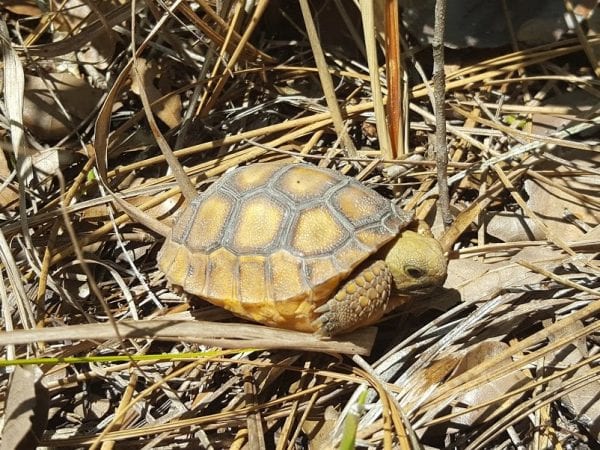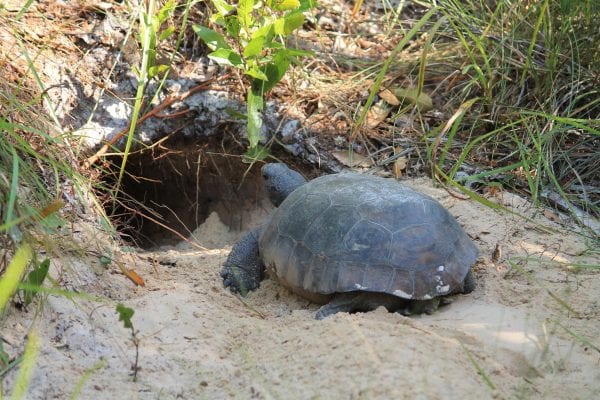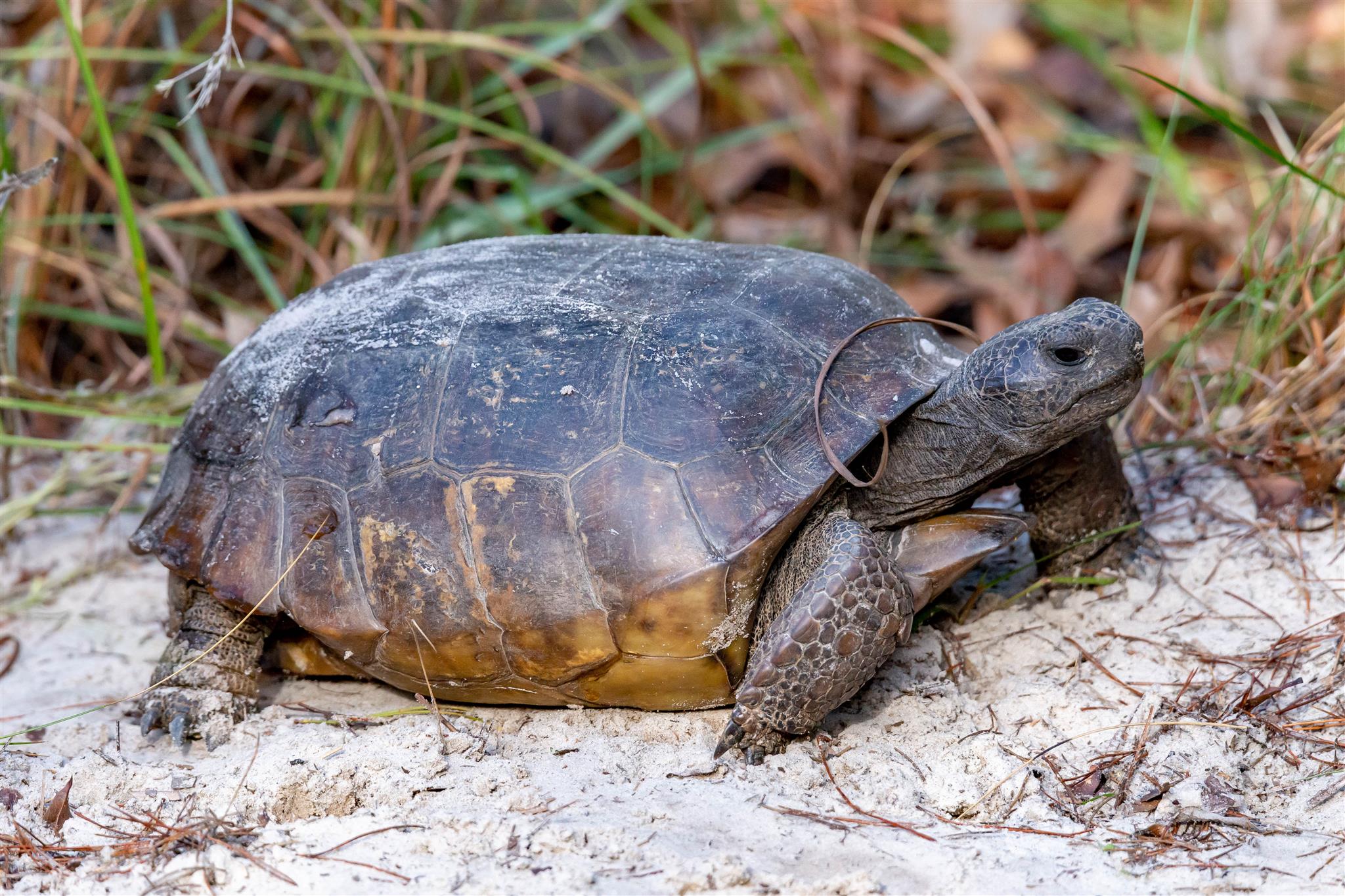Forestry & Wildlife

The gopher tortoise (Gopherus polyphemus) is a native turtle species that is found in 26 of Alabama’s 67 counties. Gopher tortoises are so named because of the burrows they dig. These burrows are dug in well-drained sandy soil, such as sandy hills in a pine savanna, and are typically 15 to 20 feet long and 6.5 feet deep. They protect the tortoises from fire and temperature fluctuations.

Young gopher tortoises have yellow coloration that will eventually fade to tan or brownish gray.
The gopher tortoise is a keystone species because many animals rely on their burrows as refuges. In fact, approximately 360 different species, such as the indigo snake and mole skink, have been documented utilizing gopher tortoise burrows. The apron of sand collected at the burrow entrance forms a microhabitat where plants grow and provides a refuge for additional wildlife species.
A Protected Species
The only tortoise east of the Mississippi River, gopher tortoises range along the Southeastern Coastal Plains of Georgia, Florida, Alabama, Mississippi, and in small parts of South Carolina and Louisiana. Across their range they receive legal protection because of population declines.
In Alabama, gopher tortoises west of the Tombigbee and Mobile Rivers are federally listed as threatened. This protection includes tortoises from Mobile, Washington, and Choctaw counties. All tortoises in Mississippi and Louisiana receive the same level of protection. East of Alabama, they are listed as threatened or endangered at the state level.
Habitats
Gopher tortoises live in areas that have both abundant vegetation and open areas for basking and nesting They are primarily herbivorous and are commonly found eating wiregrass and prickly pear. For these reasons, gopher tortoises are strongly associated with longleaf pine ecosystems. As the acreage of longleaf pine has decreased across the Southeast, so has the number of gopher tortoises. Habitat loss is the primary cause for decline of this species and includes habitat fragmentation and conversion to thickly planted pine stands. Other reasons for decline are mortality from vehicles and heavy machinery as well as upper respiratory tract disease (URTD).
Gopher Tortoise Day
Over concern for declining gopher tortoise numbers, the Gopher Tortoise Council was established in 1978. This group officially adopted April 10 as Gopher Tortoise Day to increase awareness about this important species and gopher tortoise conservation. In 2018, Alabama Governor Kay Ivey signed a proclamation that named April 10 as Gopher Tortoise Day across Alabama.
The following are additional resources on Gopher Tortoise Day and ongoing work to protect this species:
- ADCNR Gopher Tortoise Day Resources
- Gopher Tortoise Council
- Alabama Gopher Tortoise Day Proclamation
How to Help

A gopher tortoise outside the entrance to its burrow. The sandy area around the entrance is known as an apron.
There’s no better way to celebrate Gopher Tortoise Day than to do something to help these animals. There are many useful ways to assist in the conservation of this species. Many of these conservation actions coincide with already established landowner management objectives.
Prescribed fire. Prescribed burns every two to five years, depending on plant composition, can help maintain open pine systems. Prescribed burning is one of the most effective tools to manage land for gopher tortoises and many other wildlife species. Its use results in a greater diversity of herbaceous plants, on which the tortoises feed. It also increases access to suitable basking and nesting areas. Burns can be facilitated by reintroducing fire-adapted pines to an ecosystem. As part of the USDA Longleaf Pine Initiative, financial assistance can be provided for approved participants to implement conservation practices, such as planting longleaf pines.
Timber thinning. This practice, already incorporated into many silvicultural management plans, has many of the same benefits as prescribed fire. Thinning pine stands reduces canopy closure, allowing for more sunlight to reach the ground. This added sunlight helps understory plants to grow and helps the gopher tortoise regulate its body temperature.
Mowing. Woody weeds may close the midstory and reduce light entry, thereby making conditions unsuitable to the gopher tortoise. Areas without frequent low-intensity fire may grow more woody vegetation, but if prescribed burning is not feasible, mowing or bushhogging reduces woody understory plant density and improves gopher tortoise habitats. Be sure to set the blade height at 18 inches to avoid injury to tortoises.
Monitor roadways. Because gopher tortoises may get hit by a car if they cross the street, it is legal to move a gopher tortoise from the road. However, people should only attempt this if conditions are safe for the person assisting the tortoise. Move the tortoise to the shoulder of whichever side of the road it was facing when first observed. Do not touch the tortoise otherwise. It is against the law to capture, hunt, harass, possess, sell, or transport a gopher tortoise or gopher tortoise eggs.
Protect burrows. Gopher tortoises can sometimes become entombed in their burrows, so it is important to not block or disturb the burrow in any way. If there is a burrow nearby, visibly flagging a 13-foot radius buffer zone around the entrance can reduce the risk of burrow damage.
Support restoration efforts. More attention in the state is being given to restoration of longleaf pine forests. By supporting these efforts from conservation groups, such as The Longleaf Alliance, with volunteer hours or donations, gopher tortoises will have more suitable habitat. Although Alabama has fewer gopher tortoises than there were historically, habitat restoration provides one of the best chances for this species to persist in the state.
Summary
The gopher tortoise is a native species essential to the Southeastern Coastal Plain ecosystems. Gopher tortoise populations have been declining because of habitat loss, injury from vehicles, and disease. Gopher tortoise populations are being helped thanks to groups such as the Longleaf Alliance and the Gopher Tortoise Council. Celebrate Gopher Tortoise Day by implementing prescribed burns, controlling woody weeds, monitoring the roadways, protecting gopher tortoise burrows, and supporting restoration efforts.

